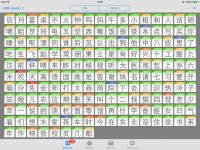Alexis
状元
Most of the data for this flashcard list was compiled by members of the Reviewing the Kanji forum. Attached is the Pleco-formatted Flashcard txt file.
Please note:
Traditional variants are NOT included because the grouping/ordering of characters between the Heisig Traditional/Simplified books are different.
If you are interested in studying HSK Vocabulary in parallel with Heisig (ie. HSK Vocabulary is sorted according to the order the characters are introduced in Heisig), you can get that here: http://www.plecoforums.com/viewtopic.php?f=7&t=3185
-----------------------------------------------------------------------------------------------------------------
(Optional) Suggestion for Studying Heisig with Pleco Flashcards.
Some of the Chapters are too big to be learned in one setting. Since Heisig is meant to be studied sequentially, even within Chapters, here is one way to setup your flashcards to avoid testing you on characters that you haven't yet reached in the chapter:
1) Set up a category "RSH Exclude"
2) Go to Review Flashcards->Card Filter. Go to "Category Filter 1", Select "Exclude", then chose the "RSH Exclude" Category
Now when you start a new chapter you can copy over the cards in your chapter to the "RSH_Exclude" category. As you sequentially learn the cards, remove them from the "RSH_Exclude" category (note: Don't delete the cards!)
-----------------------------------------------------------------------------------------------------------------
Version 2 Update Notes (Don't worry about this section if you haven't previously imported the previous version of this deck:
Before re-importing:
It is tempting to just delete the old cards and import again, but remember that this will also delete the scores associated with your cards. If you do go this route, only do it for the categories that you haven't studied yet). Otherwise, just manually fix up the few cards changed in this release:
Changes made in Version 2:
1) Added Parent Category "Remembering Simplified Hanzi"
2) Fixed a few characters/formatting
恒 Héng [1798] permanent (RSH2_21)
征 Zhēng [1993] solicit (RSH2_24)
捞 Lāo [2127] scoop up (RSH2_27)
匠 Jiàng [2677] artisan (RSH2_43)
萨 Sà [2711] Samoa (RSH2_44)
佣 Yōng [2776] put to work (RSH2_47)
虐 Nüè [2913] despotic (RSH2_53)
3) Added Missing Keyword:
冲 chōng [432] collide (RSH1_18)
复 fù [472] duplicate (v.) (RSH1_18)
4) Corrected/Added Pronunciation
划 huá [363] scratch (v.) (RSH1_16)
扮 Bàn [1945] play the part of (RSH2_23)
5) Fixed up Categories:
晕 Yūn [1634] dizzy (RSH2_10 => RSH2_14).
Please note:
- The definitions for this list consist of Heisig's character index (for cross-reference with the books) and the main keyword. The definitions will only be of real use if you have a copy of the books (both available from http://www.uhpress.hawaii.edu)
- When importing make sure to set "Duplicate Cards" to "Allow", "Definition Source" to "File Only", and "Text Encoding" to "UTF-8"
- Characters are categorized per book/lesson (ie. rsh2_05 refers to Book 2, Lesson 5). The top category is called "Remembering Simplified Hanzi"
Traditional variants are NOT included because the grouping/ordering of characters between the Heisig Traditional/Simplified books are different.
If you are interested in studying HSK Vocabulary in parallel with Heisig (ie. HSK Vocabulary is sorted according to the order the characters are introduced in Heisig), you can get that here: http://www.plecoforums.com/viewtopic.php?f=7&t=3185
-----------------------------------------------------------------------------------------------------------------
(Optional) Suggestion for Studying Heisig with Pleco Flashcards.
Some of the Chapters are too big to be learned in one setting. Since Heisig is meant to be studied sequentially, even within Chapters, here is one way to setup your flashcards to avoid testing you on characters that you haven't yet reached in the chapter:
1) Set up a category "RSH Exclude"
2) Go to Review Flashcards->Card Filter. Go to "Category Filter 1", Select "Exclude", then chose the "RSH Exclude" Category
Now when you start a new chapter you can copy over the cards in your chapter to the "RSH_Exclude" category. As you sequentially learn the cards, remove them from the "RSH_Exclude" category (note: Don't delete the cards!)
-----------------------------------------------------------------------------------------------------------------
Version 2 Update Notes (Don't worry about this section if you haven't previously imported the previous version of this deck:
Before re-importing:
- Back up your flashcard database (Flashcard Main Screen -> Backup Database). This will allow you to restore your previous database if necessary.
- Set "Duplicate Cards" at "Update Text" when you import.
- Make sure that your existing cards are in a parent category called "Remembering Simplified Hanzi"
It is tempting to just delete the old cards and import again, but remember that this will also delete the scores associated with your cards. If you do go this route, only do it for the categories that you haven't studied yet). Otherwise, just manually fix up the few cards changed in this release:
Changes made in Version 2:
1) Added Parent Category "Remembering Simplified Hanzi"
2) Fixed a few characters/formatting
恒 Héng [1798] permanent (RSH2_21)
征 Zhēng [1993] solicit (RSH2_24)
捞 Lāo [2127] scoop up (RSH2_27)
匠 Jiàng [2677] artisan (RSH2_43)
萨 Sà [2711] Samoa (RSH2_44)
佣 Yōng [2776] put to work (RSH2_47)
虐 Nüè [2913] despotic (RSH2_53)
3) Added Missing Keyword:
冲 chōng [432] collide (RSH1_18)
复 fù [472] duplicate (v.) (RSH1_18)
4) Corrected/Added Pronunciation
划 huá [363] scratch (v.) (RSH1_16)
扮 Bàn [1945] play the part of (RSH2_23)
5) Fixed up Categories:
晕 Yūn [1634] dizzy (RSH2_10 => RSH2_14).

